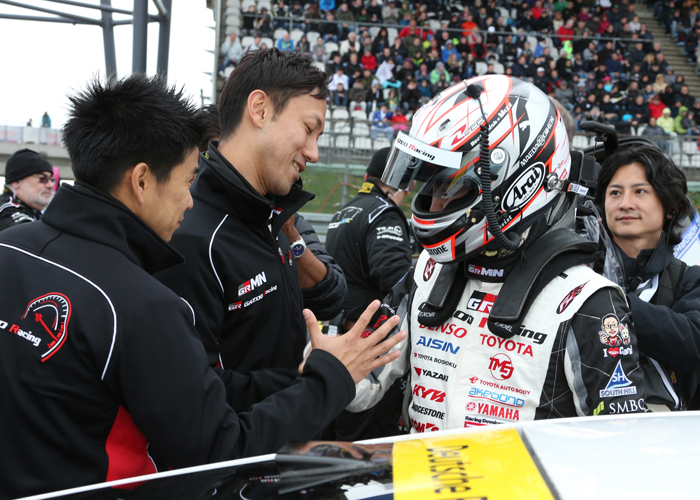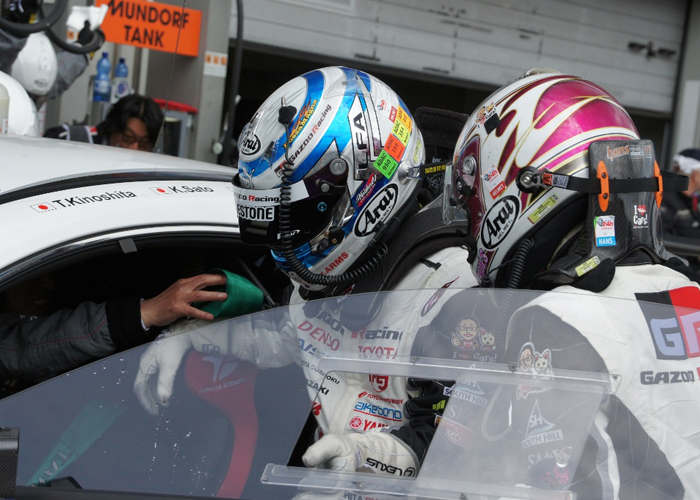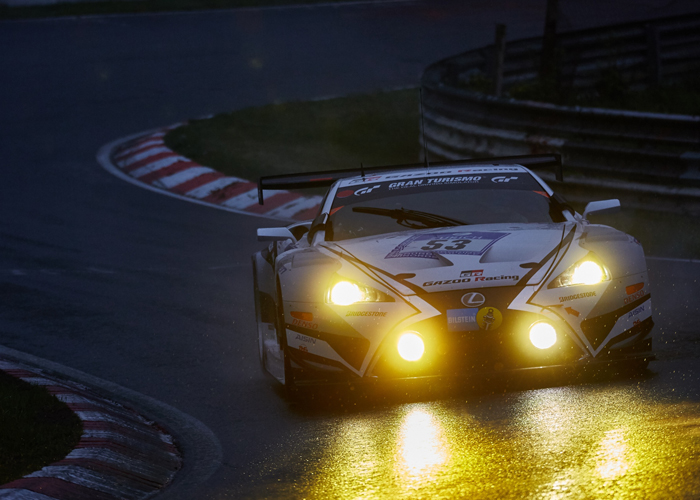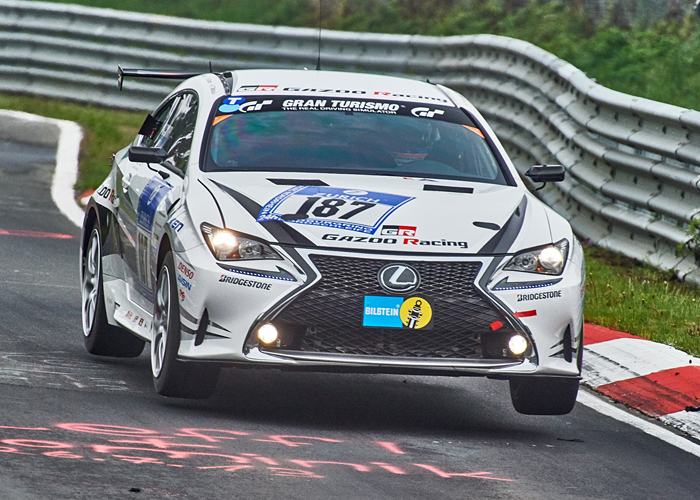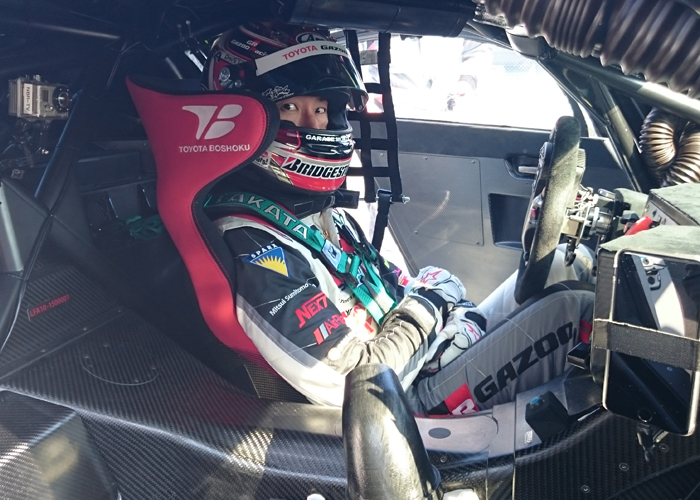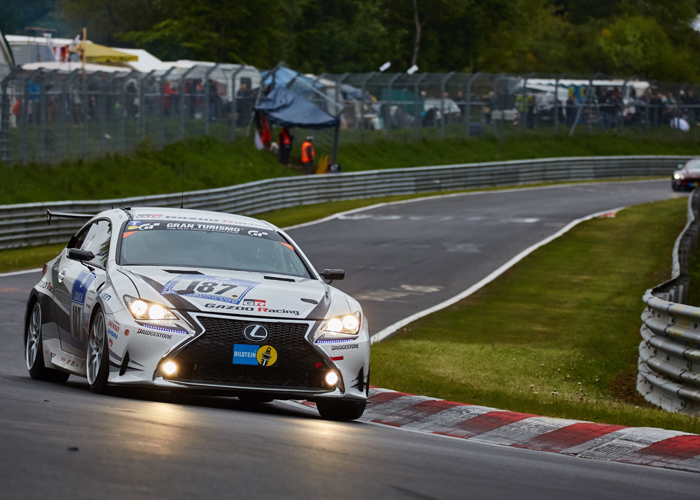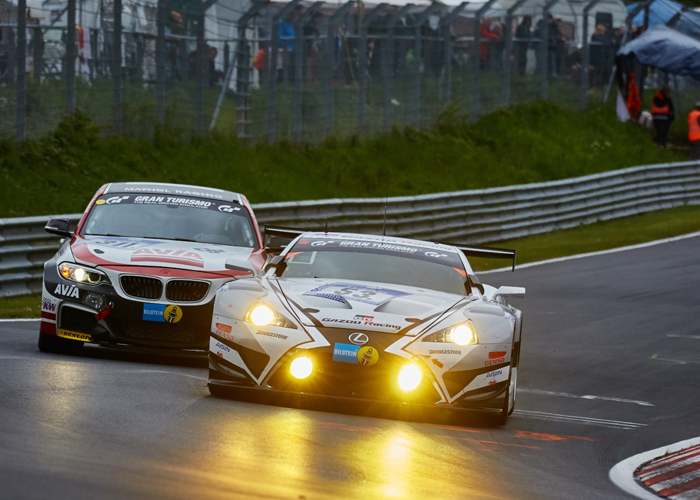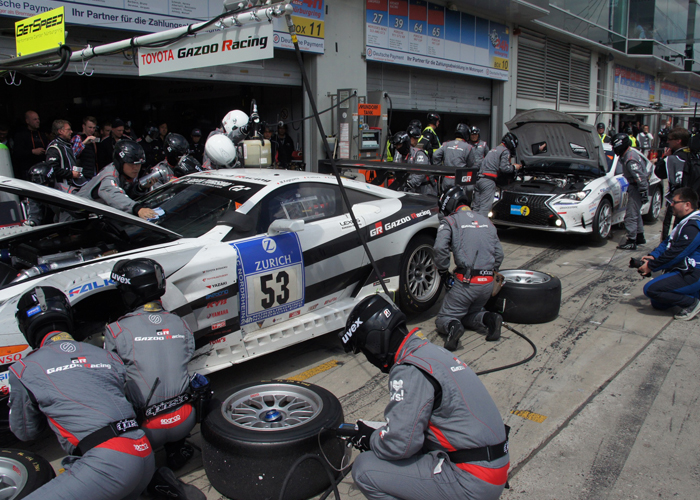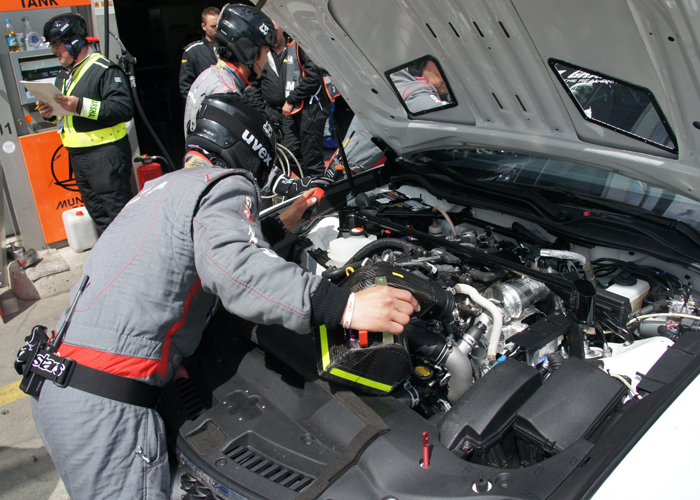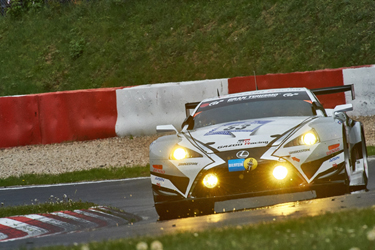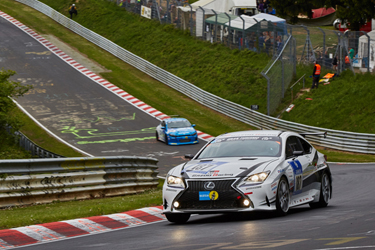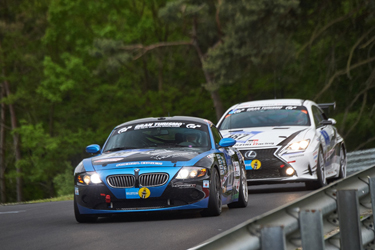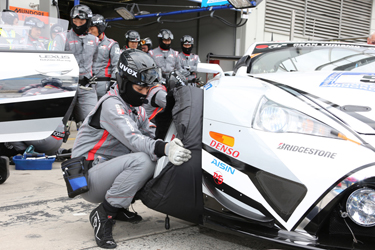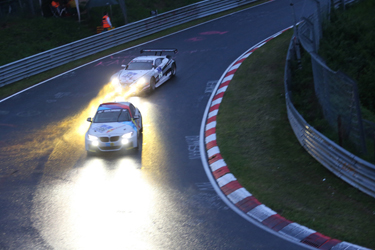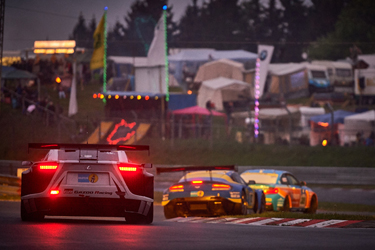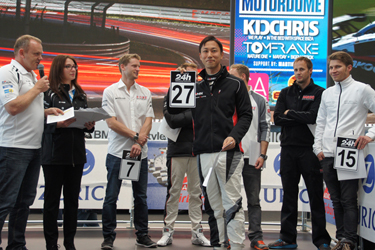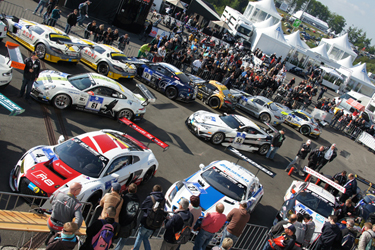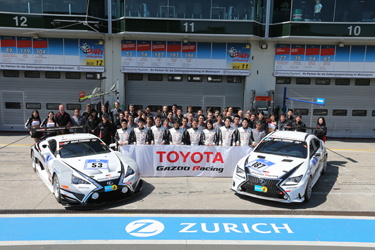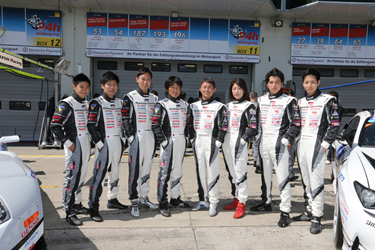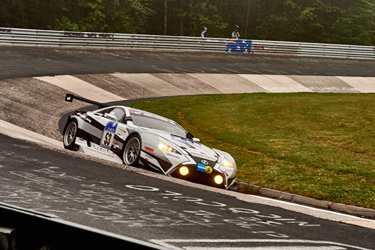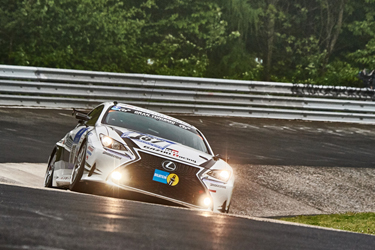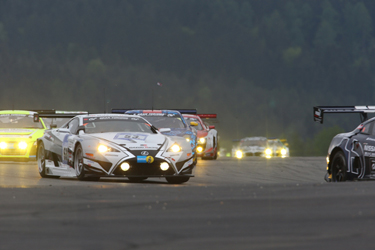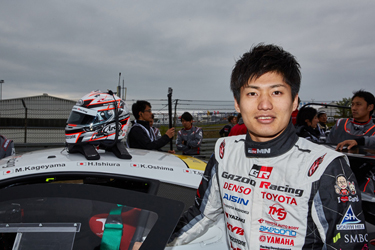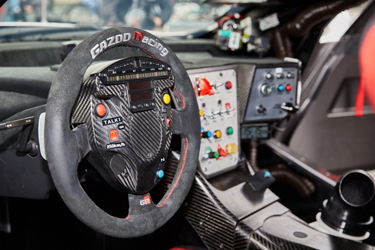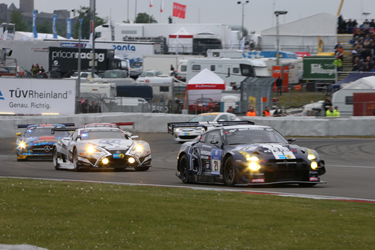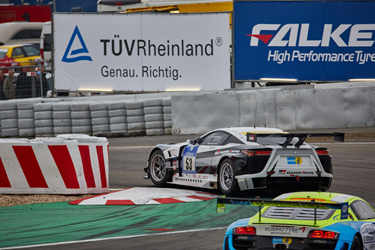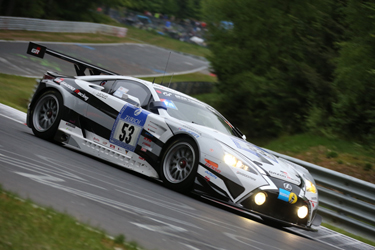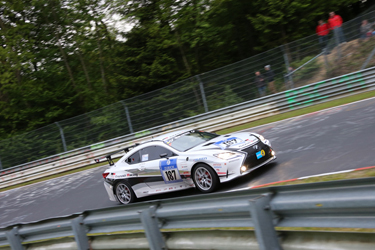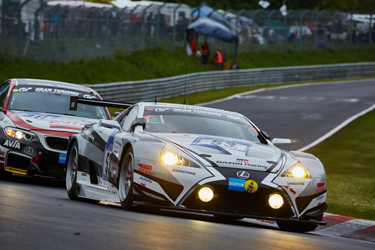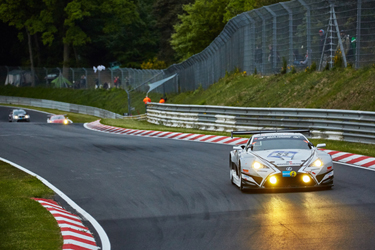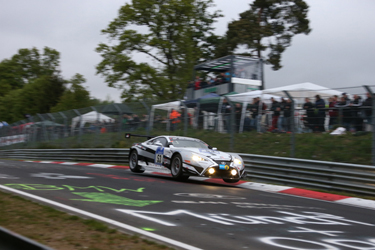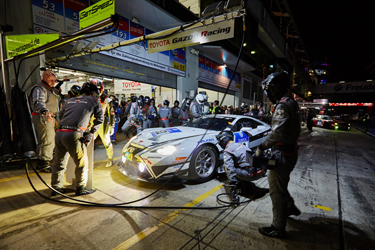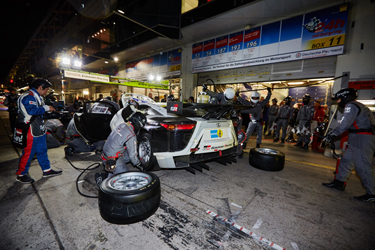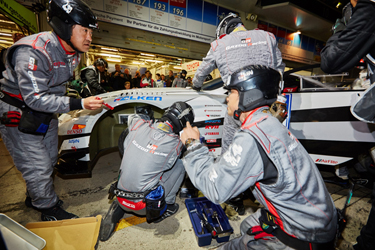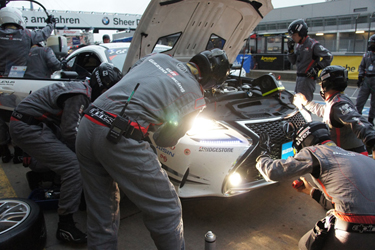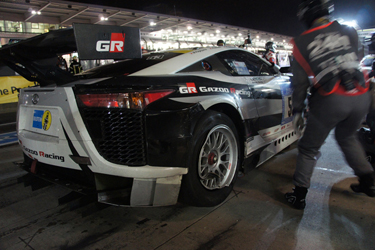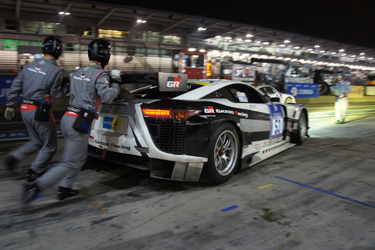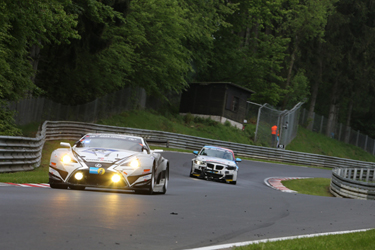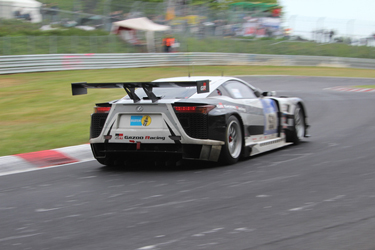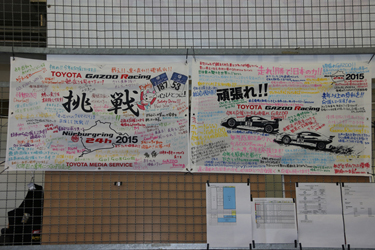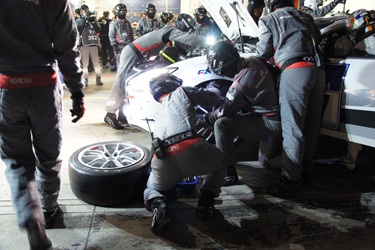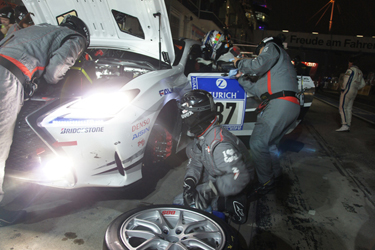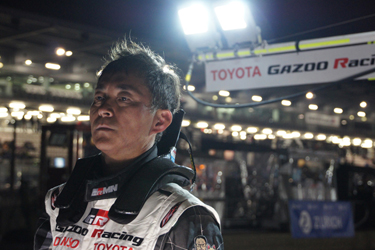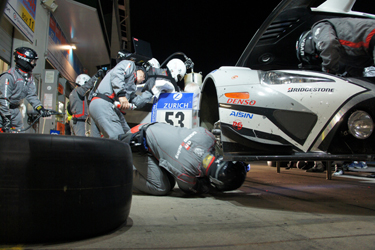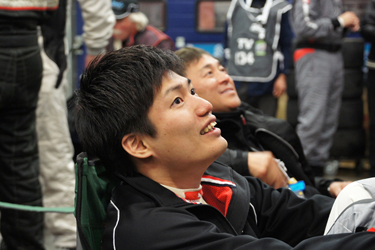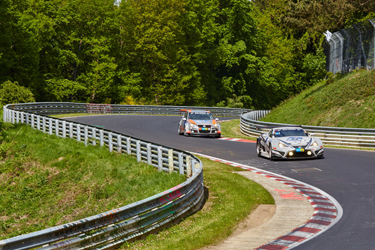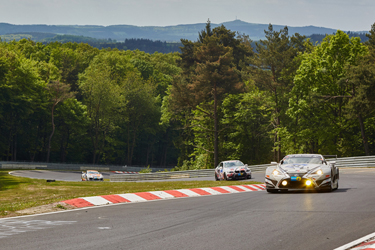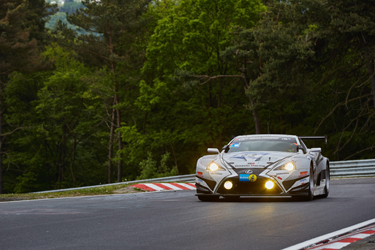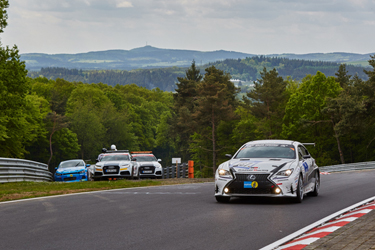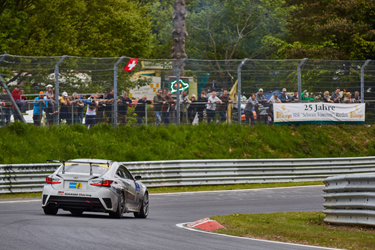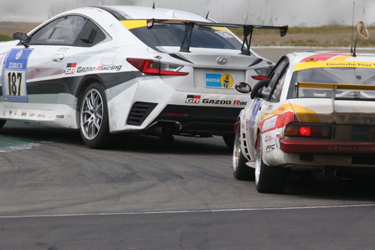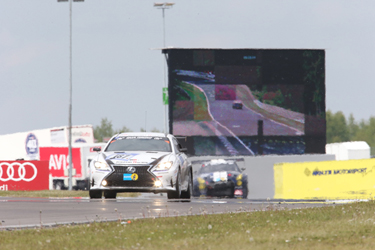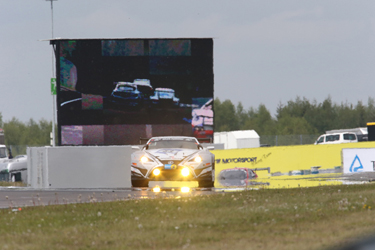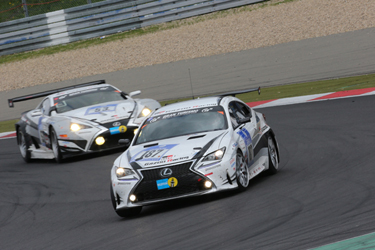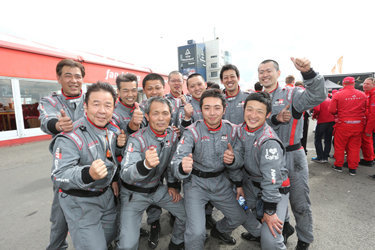For the Toyota GAZOO Racing team, its ninth year of competition at the 24 Hours of Nürburgring Race was not only about winning or losing. Nürburgring is considered the most challenging course in the world, and the race is a 24-hour endurance test tempering man and machine. Toyota sees the course as an ideal testing ground to develop ever-better cars. Toyota Motor Corporation has been loyal to this race concept since it first started competing in Nürburgring in 2007.
2015 24 Hours of Nürburgring Race: Back to the Basics for GAZOO Racing
In 2007, at its inaugural competition at the 24 Hours of Nürburgring Race, Toyota entered the LEXUS IS. The model had gone out of production in 2005, so Toyota was essentially entering a used car. Morizo, Toyota Motor Corporation president and team leader of the Nürburgring race, recalled his experience with the LEXUS IS back in 2007.
“We trained for the 24 Hours of Nürburgring Race with a used vehicle and then we entered it in the race. Our competitors were racing vehicles they would be taking to market in two-to-three years. Our chief driver Hiromu Naruse and I became determined to develop a Toyota vehicle that beats other cars, instead of one that always gets beaten.”
With that in mind, Toyota entered the LFA development vehicle LF-A in 2008. Before that, the company’s development of new cars had been top-secret. But Toyota changed that thinking 180 degrees in its quest to make ever-better cars. The company realized it needed Nürburgring to be its testing ground for great-driving cars. But it wasn’t just the cars that needed to be reinvented; the engineers also needed to reform their thinking. This approach was adopted not only for the LFA, but also the FR-86 concept car.
In 2014, all three vehicles entered into the Nürburgring race (LFA/LFA Code X/86) won first place in their respective class, which is Toyota’s biggest success since it started competing in the race. For 2015, Toyota renewed its challenge by replacing both the LFA, which had competed since 2008, and the 86, which had competed since 2012. The new vehicles were both development test vehicles.
“Last year, all three of our cars took first place in their classes, but we can’t sit around and boast about it,” said RC team leader Nobuaki Kanamori. “That’s why in 2015, we went back to the basics of GAZOO Racing, which is making ever-better cars. In 24Hours of Nürburgring Race, our young employees, who are amateurs when it comes to race, take the lead in doing work and making decisions. We consider that these activities would lead to instill “making ever-better cars.”President Toyoda has said, ‘We’re participating in the race, but we’re not racing.’ That’s what Nürburgring is about for us.”
Lexus LFA Code X in its 2nd year; Lexus RC its 1st
Young mechanics in their 20s take the lead
The LEXUS LFA Code X vehicle was based on a production model and entered into the SP-PRO class, which allows for a broad range of modifications. The vehicle was in its second year of competition and had four drivers for 2015: Masahiko Kageyama, Hiroaki Ishiura, Kazuya Oshima, and Takuto Iguchi.
While its name was unchanged, the LFA was developed as a super sports test vehicle with a host of new features, including a long wheelbase and short-overhang packaging, full-carbon monocoque body, push-load suspension, V10-5.3L engine, and twin-clutch transmission. In 2014, its first entry into 24 Hours of Nürburgring Race, the LFA finished 11th overall and first in the SP-PRO class. Despite this success, the vehicle hadn’t tapped its full potential.
“Although we went full-out last year, there were concerns over reliability in terms of extreme heat and strength,” says LEXUS LFA Code X team leader Naoaki Ito. “We controlled the vehicle so issues didn’t crop up. This year, we’ve learned from our experience. While the major structures are the same as last year, we’ve redesigned rigidity balance and aerodynamics as part of a complete overhaul. The result is that we’ve raised the potential even further than we imagined possible. Of course, we want to improve on last year’s results in various ways.But if we can concentrate on keeping the pace we originally set, it will yield results eventually.
The second vehicle, the LEXUS RC, is driven by Takayuki Kinoshita, Kumi Sato, Naoya Gamou, and Takamitsu Matsui. As seen from the fact that this RC entered SP3T class (1.4~2.0 turbocharged engine standard), it is sporting a combination of a 2L direct-injection turbocharged engine and a 6-speed AT, which is not found in the mass-production vehicle. “The RC has a new power unit, but besides that, it’s just a modification of the base mass-production vehicle,” says team leader Nobuaki Kanamori. “As with the LFA Code X, the RC is a long-term development project. The race engine has to be a ‘closed product,’ meaning we can only make modification within the bounds of the regulations. Although we’ve also lowered the vehicle’s weight by about 300kg from the mass-production vehicle, the exterior hasn’t been changed much, and we didn’t adopt carbon in place of steel or change other materials to save weight. We’ve deliberately stuck to the rules to develop this racing vehicle.The team members tend to work too hard when it comes to the race, but it’s my job to keep things under control.”
A six-member mechanic team was assigned to each of the vehicles. Instead of professional racing mechanics, the teams comprised mechanics chosen internally from among Toyota’s vehicle development departments, with an average age in the 20s. Most of the members were new to racing. Since being selected in January, the members have gained experience during vehicle production and mechanics training sessions with veterans. Masaharu Koike, the mechanic leader for the RC team, is the oldest, at 33. “It’s a young team, and there are advantages and disadvantages to that,” says Koike.“It is good that we’re not afraid to speak our minds around each other. But at the same time, since we’re all about the same age, our mood tends to be too cozy. The veterans don’t say much to us, but they do come by a lot to check on us (laugh). Our teamwork’s getting better by the day.”
Hiromu Naruse, a Toyota master test driver who passed away in 2010, used to say: “Racing is the ultimate stage on which to pass on technologies and train personnel. What is important is not so much theorizing about car-building with words and data, but rather actually putting parts in their places, touching them with your hands, and understanding them with your eyes.” The youthful mechanic teams have taken these words to heart and strive to put them into practice.
Beating the qualifying results by racing 1 second, 1 minute faster and one lap longer 24 hours later in the final
Essentially, the racing opened May 14 with the free practice and the first qualifying round. The free practice sessions took place in completely dry track conditions. The LFA Code X used the sessions to perform machine checks and burn-in brake rotors for the qualifiers and final race. The RC, meanwhile, used the free practice to change setups and make other adjustments for the qualifiers and final race.
The first qualifying round was held over a four-hour period, from 19:25 to 23:25. That may seem like a long time, but even the highest lap is a little over 8 minutes, and as each driver is obligated to drive at least two laps, there was little time for rest.
Rain began to fall just before the end of free practice runs and got heavier closer to the qualifier, leading to wet conditions for the first qualifying round. In mid-May, the sun doesn’t set in Germany until around 22:00. The qualifier therefore started in daylight, continued past sunset and into the night, leading to gradually changing race conditions as it progressed. The LFA Code X and RC were both set up for wet track conditions and the vehicles equipped with intermediate tires for the qualifier.
In the preliminary race (QF race) to the 24 Hours of Nürburgring Race held April 12, the LFA Code X came in third overall in the qualifier and 16th place overall in the final race (first in the SP-PRO class), earning it a “Blue Flash” (high luminance LED) designation. This automatically qualified it for the top-30 qualifier at 24 Hours of Nürburgring Race, and therefore the vehicle didn’t make an aggressive run at the initial round of the Nürburgring qualifiers. Despite that, as the track conditions improved in the second half of the qualifier, driver Takuto Iguchi set a time of 10 mins 1.614 secs and took second place in the SP-PRO class.
“I took the top time among our drivers because the track was nearly dry during my run, but Ishiura’s run was more significant for us because we were able to confirm the handling improvement under wet conditions, an issue we’d had at the VLN2,” Iguchi said.
The RC ran its second-round qualifier the next day. With a forecast of good weather, the team gave each of the drivers the prescribed number of laps and conducted light checks during the night runs. Naoya Gamo was the fastest, with a time of 11 mins 24.255 secs, earning fifth in the SP3T class. “The rain was falling hard at the start of the qualifiers, but it got drier as the race continued and we tried different setups with each driver. We knew that the forecast was for good weather the next day, so we didn’t want to push it too much, but wait and attack the track the next day,” said Gamou.
On the second day, the second-round qualifier ran from 09:30 to 11:30, and the top-30 qualifier from 17:10 to 17:50. The LFA Code X was driven only by Ishiura, whose goal was not to push for a faster time but to make vehicle adjustments in preparation for the final race.
The RC, on the other hand, made an attack run to improve its time. Young drivers Naoya Gamo and Takamitsu Matsui took the wheel, with Gamo setting a time of 10 mins 00.116 secs, good for 88th overall and fourth in the SP3T class.
In the final top-30 qualifier, which comprised the 18 seeded vehicles and the 11 remaining vehicles from the qualifiers, Ishiura set a time of 8 mins 26.280 secs, putting the LFA Code X in second place and just 0.076 off the top SP-PRO qualifier’s time, and in 23rd overall. This ensured GAZOO Racing a front-line position, which was best in any previous history of its 24 Hours of Nürburgring Race challenges. (For comparison, in 2014, the LFA Code X had a top-30 qualifier race time of 8 mins 35.746 secs and the LFA had a time of 8 mins 29.988 secs.)
“We beat last year’s LFA time by nearly 5 seconds, so the vehicle’s improvements were showing in faster times,” said Ishiura. “Even as we ran the qualifier with a final race setup instead a qualifier setup, we came in second, so this gave us confidence we could aim for first in the final race.” Ito added: “We’d had very little trouble through the top-30 qualifier, and we were a little frightened that things were going almost too well. With the same time in the QF race, we could prove that it wasn’t just a plain luck. The only thing left was to see where we’d be positioned 24 hours later for the final race.”
Before the start of the race on May 16, everyone involved in the team, including the drivers and mechanics, gathered for a meeting led by team leader Morizo, who recalled his own experiences at the Nürburgring with Hiromu Naruse, Toyota’s former chief test driver. “Looking back, the years up to 2007 were a preparation period for us. From 2007 through 2010, Naruse pulled us through as our leader. We lost our leader in the four years between 2011 and 2014, but we’ve come together as one. This year, let’s take our success to new levels. I want Naruse(-san) to see what each of our member is doing and how hard they are working.
This year, we’ve entered a new vehicle into the race, and the qualifying runs have been good. Let’s first make sure we finish the race. Then, I want you to drive one second, one minute faster and one lap longer than last year. Please pass down to future teams our tradition of safety and creating ever-better cars. We have many staff here from all over Toyota. Let’s forget what departments we’re from and what company we represent and all join together as members of the Toyota GAZOO Racing team.”
Both cars run well until demons of Nürburgring strike
The 24-hour race started at 16:00. Kazuya Oshima was behind the wheel for the LFA Code X, while Takayuki Kinoshita took the wheel of the RC. Right from the start, the LFA Code X kept steady with vehicles from the higher SP9-GT3 class, demonstrating its great potential during the final race. Because of accidents at this year’s VLN1, speed limits were in effect for dangerous areas of the course. Despite that, the LFA Code X ran a faster lap time than last year. The drivers noted the difference, commenting that even though the vehicle didn’t look much different from last year’s model, the improved rigidity of the body (especially the rear area) and the enhanced down-force made the vehicle feel fast and easy-to-drive in either dry or wet conditions.
The skies were cloudy at the start of the race, but gave way to rain about an hour into the competition just before the first driver change. Since rain was already falling over some parts of the course, teams were unsure whether or not to change tires. With safety a top priority for GAZOO Racing, the orders for a tire change were given. Mechanics quickly changed to intermediate tires and sent the vehicles back on the track. When the rain stopped and the track began to dry, another change was made to dry tires, and at this stage the LFA Code X was 27th overall and first in its class, while the RC was 73rd overall and third in the SP3T class.
The sun began to set around 21:00, marking the start of the night session. Both vehicles were running well. Around 23:00, during a driver change from Oshima to Ishiura, the LFA Code X was refueled, tires changed, and brakes changed. Thanks to the fast and accurate work of the mechanics, the work was completed within the usual pit time, and the vehicle was still in first place as it returned to the track.
Several minutes out of the pit, however, Ishiura radioed that the LFA Code X had made contact with the marshal’s vehicle and sustained damage to its right-rear. The mechanics prepared replacement parts and tires and awaited the vehicle’s return to pit.
As repairs started after the vehicle’s return, the wheel and body panel were found to be damaged but the extent wasn’t severe, and the vehicle was back out of the pit in about 8 minutes with four new tires and a repaired panel. The driver allayed the team’s concerns by radioing that the car was functioning normally.
Both vehicles continued to drive through the night session without incident, leaving mechanics to comment that there was a “frightening” lack of issues. “We were amazed that the RC was running third in its class because we were up against true race cars with a modified mass-production car,” commented one mechanic. A mid-level engineer noted: “The skills of the mechanics have really grown when you think of where they were when the team was formed in Japan. They’ve become even more reliable with the experience they’ve built during the race week. It’s a good group of people eager to improve, so I’ve got high hopes for them in the future.”
At 6:00 a.m., both vehicles were still going strong. The sole issue was that Ishiura was barred from driving for ignoring the yellow flag following the contact with the marshal’s car the previous evening. Past 9:00 a.m., the LFA Code X was still leading the SP-PRO class and was 17th overall, while the RC had risen to second in the SP3T class and 37th overall.
In the afternoon, with about two hours to finish, both vehicles reported trouble after a largely trouble-free race. The LFA Code X was unable to engage sixth gear, while the RC suffered power outages while driving. The LFA Code X kept running, as it could continue using up to fifth gear without much loss of speed. During pit stops, data was drawn from the vehicle and engineers continued working on fixes until the end of the race. For the RC, during its pit stop the mechanics shut down the wiring causing the power outage and the vehicle returned to the race after the problem indicator disappeared.
For the final stint, Takuto Iguchi took the wheel of the LFA Code X and Kumi Sato drove for the RC team. Despite some concern over the mechanisms, both vehicles continued on the last laps with minimal drop in speed. On the last lap, the vehicles came together on a planned rendezvous and crossed the finish line together at 16:00. Both had overcome minor issues to drive nearly nonstop for 24 hours. In the end, the LFA Code X finished 14th overall and first in the SP-PRO class, while the RC finished 39th overall and fourth in the SP3T class.
Both the vehicles and team members grow from the race!
“Thanks to everyone, we achieved our goal of winning our class,” said LFA Code X driver leader Masahiko Kageyama after the race. “It’s regrettable that we didn’t surpass the overall ranking from last year’s race, but for the LFA Code X to run virtually trouble-free in its second year was a great success.”
RC driving leader Takayuki Kinoshita noted his team’s satisfaction with finishing the race without incident: “It’s unfortunate that we lost some ground at the end, but I’m honestly pleased that in its first year, the RC finished the race without any major problems. None of the four drivers made a big mistake, and with our strong communication, it was the best driving combination possible.”
Yasuo Hirata, the chief mechanic who led the team of young mechanics since its formation in January, discussed his team’s growth. “At the start of our effort, I honestly felt the team wasn’t making much progress. But during the final race, watching the members work, I found they had come into their own. It wasn’t just their work during the race. It was their preparation and their desire to get something done when they had time. I realized how much they’d grown. It was like a parent watching his children grow. They’re all good listeners, so I expect them to be more aggressive in the future.”
Following the race, team representative and company President Akio Toyoda addressed everyone involved with the team: “For me, more than the final positions, I am happy that everyone worked together to develop the two vehicles, and that they were both able to complete the race. After we reached the goal and I looked around at everyone’s faces, I was overcome with a feeling of satisfaction that we’ve continued Toyota GAZOO Racing and a feeling that we must drive ahead. This is the fifth year since the passing of our leader Naruse, and I think we came together as one and showed him that we could do it. This was also our first entry as GAZOO Racing. Although my own perception of the team hasn’t changed, other people think this has become Toyota works. “What are they doing now at Toyota works?” I want this to be an aggressive message to the racing world and raise our presence in it.
“Please support us as we continue to participate in the 24 Hours of Nürburgring. There’s nothing more encouraging for us than to hear, ‘Go Toyota! Go GAZOO!’ Thank you for your enduring support.”
It remains to say that this race was not the completion of a project?on the contrary, it is simply the start of a journey to create “ever-better cars.” To this end, Toyota GAZOO Racing will continue to participate in the 24 Hours of Nürburgring.
Overall ranking
Final results: 151 vehicle entries; 102 vehicles finished; 49 vehicles retired
| 1st | No.28 | Audi Sport Team WRT/ Audi R8 LMS(SP9 GT3class 1st) |
|---|---|---|
| 2nd | No.25 | BMW Sports Trophy Team Marc VDS/BMW Z4 GT3(SP9 GT3class 2nd) |
| 3rd | No.44 | Falken Motorsports/ Porsche 997 GT3 R(SP9 GT3class3rd) |
| 4th | No.26 | BMW Sports Trophy Team Marc VDS/ BMW Z4 GT3(SP9 GT3class 4th) |
| 5th | No.5 | Black Falcon/Mercedes-Benz SLS AMG GT3(SP9 GT3class 5th) |
| 6th | No.17 | Walkenhorst Motorsport powered by Dunlo/BMW Z4 GT3(SP9 GT3class 6th) |
| 7th | No.29 | Audi Sport Team WRT/Audi R8 LMS(SP9 GT3class 7th) |
| 8th | No.11 | Bentley Team HTP/ Bentley Continental GT3(SP9 GT3class 8th) |
| 9th | No.35 | Nissan GT Academy Team RJN/ Nissan GT-R GT3(SP9 GT3class 9th) |
| 10th | No.33 | Team Premio/Mercedes-Benz SLS AMG GT3(SP9 GT3class 10th) | 11th | No.16 | Audi R8 LMS ultra(SP9 GT3class 11th) | 12th | No.15 | Audi race experience/Audi R8 LMS ultra(SP9 GT3class 12th) | 13th | No.61 | Black Falcon Team TMD Friction(SP7class 1st) | 14th | No.53 | Team TOYOTA GAZOO Racing / LEXUS LFA Code X(SP-PROclass 1st) | 15th | No.18 | Walkenhorst Motorsport powered by Dunlo/BMW Z4 GT3(SP9 GT3class 13th) |
| 39th | No.187 | Team TOYOTA GAZOO Racing /LEXUS RC(SP3Tclass 4th) |
SP-PRO Class Ranking
| 1st | No.53 | Team TOYOTA GAZOO Racing / LEXUS LFA Code X |
|---|---|---|
| 2nd | No.39 | Kremer Racing / Porsche 911 GT3 KR |
*SP-PRO : SP6,7 and 8, no motor, under 4000cc
SP3T Class Ranking
| 1st | No.114 | Subaru Tecnica International/Subaru WRX STI |
|---|---|---|
| 2nd | No.116 | MSC Sinzig e.V. im ADAC/Audi TT |
| 3rd | No.117 | Scuderia Colonia e.V./ Audi TT RS |
| 4th | No.187 | Team TOYOTA GAZOO Racing /LEXUS RC |
*SP 3T : Turbo charged car, under 2000cc
Schedule
| 1st Qualifying | May 14(Thu) 19:25 - 23:25 |
|---|---|
| 2nd Qualifying | May 15(Fri) 09:30 - 11:30 |
| Top-30 Qualifier | May 15(Fri) 17:10 - 17:50 |
| Final | May 16(Sat) 16:00 - May 17(Sun) 16:00 |



